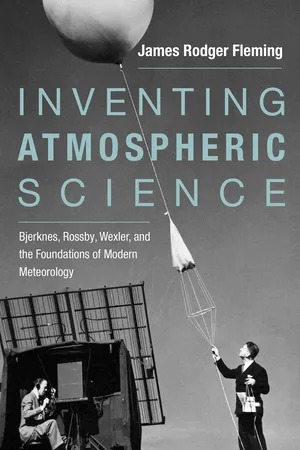
Inventing Atmospheric Science
Bjerknes, Rossby, Wexler, and the Foundations of Modern Meteorology
- English
- ePUB (mobile friendly)
- Available on iOS & Android
Inventing Atmospheric Science
Bjerknes, Rossby, Wexler, and the Foundations of Modern Meteorology
About this book
"The goal of meteorology is to portray everything atmospheric, everywhere, always," declared John Bellamy and Harry Wexler in 1960, soon after the successful launch of TIROS 1, the first weather satellite. Throughout the twentieth century, meteorological researchers have had global ambitions, incorporating technological advances into their scientific study as they worked to link theory with practice. Wireless telegraphy, radio, aviation, nuclear tracers, rockets, digital computers, and Earth-orbiting satellites opened up entirely new research horizons for meteorologists. In this book, James Fleming charts the emergence of the interdisciplinary field of atmospheric science through the lives and careers of three key figures: Vilhelm Bjerknes (1862–1951), Carl-Gustaf Rossby (1898–1957), and Harry Wexler (1911–1962).
In the early twentieth century, Bjerknes worked to put meteorology on solid observational and theoretical foundations. His younger colleague, the innovative and influential Rossby, built the first graduate program in meteorology (at MIT), trained aviation cadets during World War II, and was a pioneer in numerical weather prediction and atmospheric chemistry. Wexler, one of Rossby's best students, became head of research at the U.S. Weather Bureau, where he developed new technologies from radar and rockets to computers and satellites, conducted research on the Antarctic ice sheet, and established carbon dioxide measurements at the Mauna Loa Observatory in Hawaii. He was also the first meteorologist to fly into a hurricane—an experience he chose never to repeat.
Fleming maps both the ambitions of an evolving field and the constraints that checked them—war, bureaucracy, economic downturns, and, most important, the ultimate realization (prompted by the formulation of chaos theory in the 1960s by Edward Lorenz) that perfectly accurate measurements and forecasts would never be possible.
Frequently asked questions
- Essential is ideal for learners and professionals who enjoy exploring a wide range of subjects. Access the Essential Library with 800,000+ trusted titles and best-sellers across business, personal growth, and the humanities. Includes unlimited reading time and Standard Read Aloud voice.
- Complete: Perfect for advanced learners and researchers needing full, unrestricted access. Unlock 1.4M+ books across hundreds of subjects, including academic and specialized titles. The Complete Plan also includes advanced features like Premium Read Aloud and Research Assistant.
Please note we cannot support devices running on iOS 13 and Android 7 or earlier. Learn more about using the app.
Information
Table of contents
- Cover
- Title page
- Copyright page
- Dedication
- Contents
- Acknowledgments
- 1 Introduction
- 2 Bjerknes
- 3 Rossby
- 4 Wexler
- 5 Atmospheric Science
- 6 Final Thoughts
- 7 Notes
- 8 Bibliography
- Index